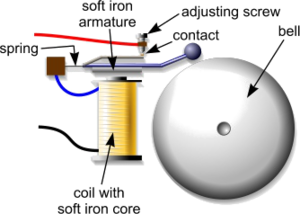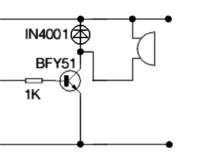Electric Bells and Buzzers: Difference between revisions
From DT Online
(Added Template) |
(Added Application Schematic) |
||
| Line 1: | Line 1: | ||
[[File: | [[File:ElectricDoorBell.png|300px|right]] | ||
__TOC__ | __TOC__ | ||
| Line 19: | Line 19: | ||
=====Buzzers===== | =====Buzzers===== | ||
[[File: | [[File:Buzzer2.png|200px|right]] | ||
[http://en.wikipedia.org/wiki/Buzzer '''Buzzers'''] are usually of the single tone variety and are normally rated between 6 and 24 volts. | [http://en.wikipedia.org/wiki/Buzzer '''Buzzers'''] are usually of the single tone variety and are normally rated between 6 and 24 volts. | ||
| Line 29: | Line 29: | ||
[[File:BuzzerCircuit.png|200px|right]] | |||
=====Buzzers in Circuit===== | |||
When a voltage is applied to the terminals of the buzzer, it emits a buzzing sound suitable for alarm circuits and warning applications. To ensure maximum sound output, the buzzer should be firmly mounted. | |||
The purpose of the '''IN4001 [[Diode]]''' shown is to restrict any [https://en.wikipedia.org/wiki/Counter-electromotive_force '''Back EMF'''] resulting from the Transistor being used to switch an inductive device ''(e.g. '''[[Electric Motor]]''', '''[[Solenoid]]''' or '''[[Relays|Relay]]'''). | |||
<div style="clear: both;"></div> | |||
{{Bells/Buzzers/Mics/Speakers Buyers Guide}} | {{Bells/Buzzers/Mics/Speakers Buyers Guide}} | ||
Revision as of 14:02, 2 November 2016
Bells
Electric bells are electromagnetic devices with contacts arranged so that once the coil is energized the armature is attracted to it and the circuit is broken.
Once broken the coil is de-energized and the armature springs back to complete the circuit once more.
Each time the armature is attracted to the coil the hammer strikes the bell. This continues in an oscillatory manner until the power is switched off.
Bells normally work on low voltage typically 6 volts. Bells are used as outputs for alarm circuits.
Buzzers
Buzzers are usually of the single tone variety and are normally rated between 6 and 24 volts.
They are suitable for alarm circuits, test equipment, timing and control.
To achieve maximum sound output from the device it should be firmly mounted.
Buzzers in Circuit
When a voltage is applied to the terminals of the buzzer, it emits a buzzing sound suitable for alarm circuits and warning applications. To ensure maximum sound output, the buzzer should be firmly mounted.
The purpose of the IN4001 Diode shown is to restrict any Back EMF resulting from the Transistor being used to switch an inductive device (e.g. Electric Motor, Solenoid or Relay).











